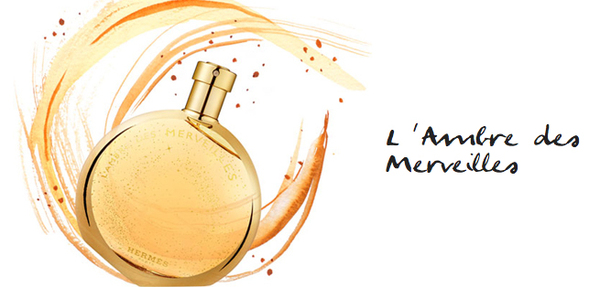Hermès L'Ambre des Merveilles (2012):The Hidden Sweet Tooth of Jean-Claude Ellena {Perfume Review & Musings}

Perfumer Jean-Claude Ellena seems to have reached a new level of maturity in his art as his penultimate perfume creation L'Ambre des Merveilles demonstrates (a new creation has recently been launched albeit so far in a limited fashion, Un Jour d'Hermès. Wait till Feburary to see it perfume more counter shelves) Complex, yet simply enjoyable, familiar yet thoroughly rethought and new in its workings, L'Ambre des Merveilles is a flanker serving as pretext - just like any source of inspiration could - to allow Ellena to express his ideas and sensitivity, his accumulated experience...
There are many threads that come together in this new composition, but instead of coming across as variations as he has been known to do so in the past {See Un Jardin Après La Mousson} - as if the notes he takes down in his Moleskine notebooks pushed him to clarity and high legibility - they make you sense an internalization of the process where perfumery accords lose their externality and formally identifiable shapes to fuse into more undefinable wholeness as art.
In other words, his latest fragrance is less about the formula, the menu, and more about the meal. The culinary analogy is not fortuitous for the composition in spite of the fact that it calls attention to the solar myth of ambergris manages to rest on a gourmand core, albeit a rather subtle one. The rose of Eau des Merveilles smells of cherry liqueur. And there is more.
To my nose, it smells in a central fashion of amber and heliotrope, the latter known as the cherry-pie note for good reasons. But Jean-Claude Ellena let on in a recent interview to French Elle magazine #3492 that if he had added any gourmand notes, they were anise and licorice. "I take as a point of departure the structure, the architecture of the perfume made of 5-6 notes, then I dress it up. The theme here was floral-woody and I warmed it up with anise, licorice, vanilla, labdanum, patchouli." He also downplayed the originality of the new perfume, preferring to put the accent on its official "flanker" label. And yet, this is not exactly how the new composition comes across as it lacks the overly faithful "good student" feel of a dutiful flanker, leaning more in the direction of an inspired flanker, with wings to it.
Because perfumery is an art that thrives on minute nuances, those and the sum of them in L'Ambre des Merveilles allow you to enjoy a significantly different qualitative experience. The familiar is present but less mechanical than in some of his other perfumes where ancient accords might have a more isolated quality.
In another interview given to Be.com, he also revealed - as the self-proclaimed illusionist that he is - that he had also added a note of sesame, with a nuance of peanut butter, which is a reference to his former play on that note in L'Artisan Parfumeur Bois Farine inspired by a flavorful tree in Madagascar.
What comes to light is that a perfumer known for his ethereal textures and original, broadcast dislike of vanilla, the highly sweet note that can be either English custard or Shalimar as perfumer Ernest Beaux once expressed, is committed more discreetly, yet undeniably to a gourmet palette of gustatory nuances.
Tapping into familiar sonorities, like that of the near-edible baked apple pie and tobacco accord of Hermès Hermessence Ambre Narguilé, the perfumer continues to believe that a core appeal to our gustatory instincts, however taken to a more sublime level, is necessary to anchor the abstract form of the perfume into reality.
L'Ambre des Merveilles is rosy at first, then citrusy and ambery - it feels very delicate and precious. It makes you think of bonbons perhaps due to the crystalline nature of the amber accord evoking the hard-sugar of candies. Jean-Claude Ellena has managed to lift amber out of its muddy envelope and earthier components to make it feel much lighter, but also essentially solar in character.
As the perfume dries down, it becomes surprisingly green and herbaceous as if a perfumer had discovered some fossilized plants in the ambergris harvested from a sperm whale and imagined their smell. But it is not just green, it is also unusually dry and floral, the latter sensation going in the direction of Paperwhite narcissuses. A note of heliotrope gives an almondy softness and marzipan nuance to the scent.
The long, last, lingering accord is unusual. It could be a liqueur made by monks in a convent tucked away in the Alps, a Chartreuse of sorts, but much more ambery. It feels like the heliotrope/cherry and amber accord is key here. The drydown is very complex.
There is something in L'Ambre des Merveilles that makes you think of the new contrast found in Shalimar Parfum Initial between the bright bergamot and the slightly animalic yet impulsive, youthful amber. This impression precedes my discovery of the remark made to Be.com that the amber in L'Ambre des Merveilles is both "carnal and childlike". The perfumer describes it also as being "warm, voluptuous, very solar and a bit regressive..."
That dark cherry note which is often a nuance found in licorice accords, invites you to remember some wafts coming out of a Guerlain boutique which would be emanating from La Petite Robe Noire. Despite this air du temps notes, the new fragrance is really an oeuvre unto itself. It in fact makes you sense that Ellena has attained a new peak in his art, as I said before. It is an eminently wearable piece of perfume art which is never boring and always ready to let a pleasing nuance escape thanks to great mastery.
Jean-Claude Ellena has always stressed that he seeks to please first and foremost, which is the joie de vivre aspect of French perfumery. Indeed, while many might view French perfumery as brainy, intellectual and difficult - if not smelly - it is just as much capable of being mindlessly hedonistic, at least in appearance. Let's say, that to create that effect of lightness of being, a tremendous amount of both collective and individual work and intelligence is necessary.
See also Interview around L'Ambre des Merveilles
Image via Be










